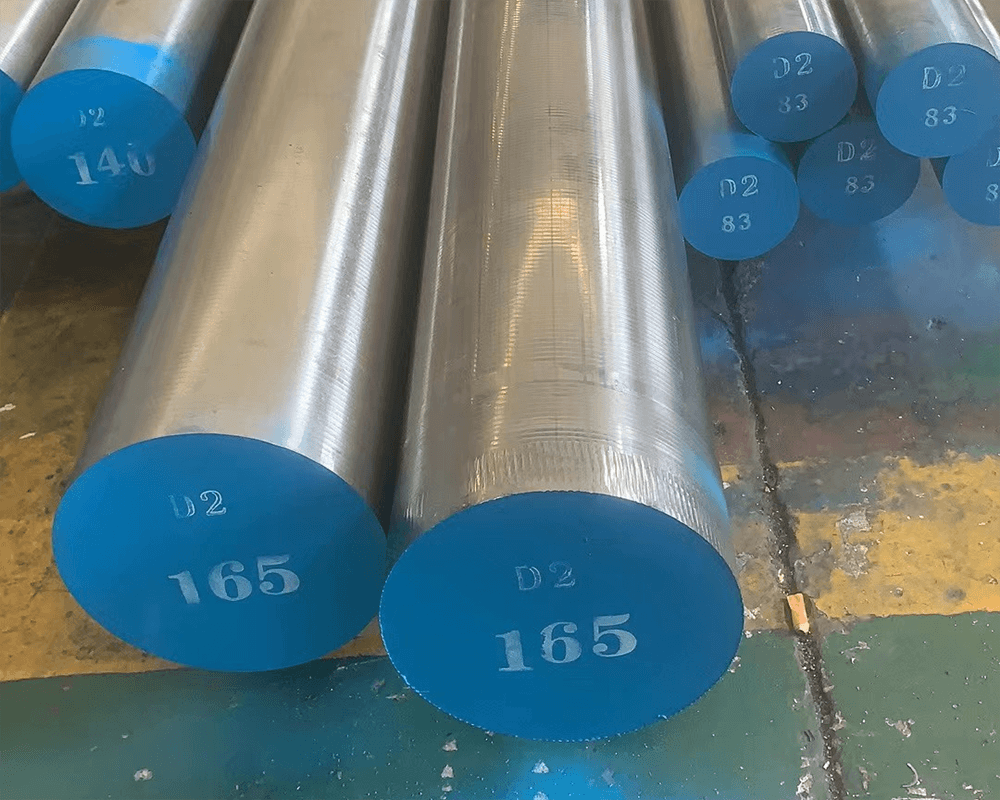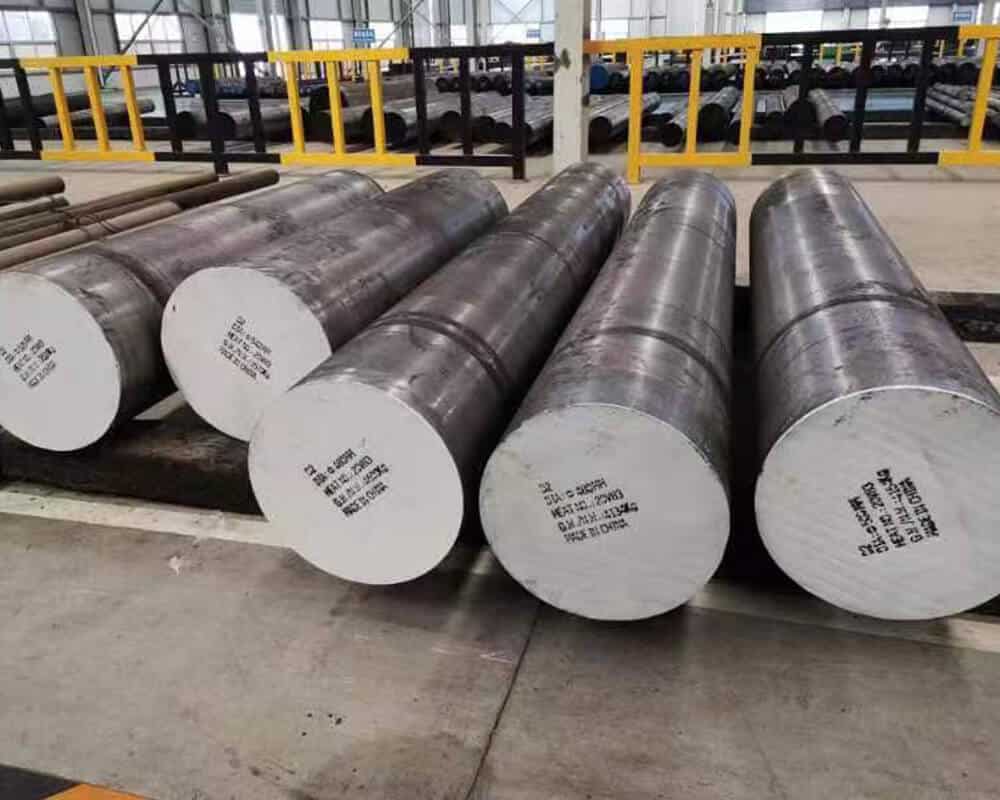
Cold Work Die Steel
Here are some key characteristics and common applications of cold work tool and die steels:
Characteristics:
High Hardness: Cold work tool and die steels exhibit high hardness, making them suitable for cutting, shearing, and forming operations.
Wear Resistance: They offer excellent wear resistance, ensuring long tool life and reduced maintenance.
Toughness: These steels maintain their toughness even at low temperatures, preventing brittle fracture during cold working processes.
Good Dimensional Stability: Cold work tool and die steels maintain their dimensional stability during long-term use, ensuring consistent part quality.
Good Machinability: Some grades of cold work tool and die steels are designed for good machinability, allowing for ease of fabrication and tool manufacturing.
Common Applications
Blanking and Shearing: Cold work tool and die steels are used for the fabrication of cutting and shearing tools for processes like blanking, shearing, and trimming of sheet metal and other materials.
Cold Extrusion: These steels find use in cold extrusion dies for manufacturing products like screws, bolts, and small metal parts without the need for elevated temperatures.
Drawing: Cold work tool and die steels are employed for dies and punches used in metal drawing processes, such as wire drawing, tube drawing, and deep drawing for components like wires, tubes, and automotive parts.
Cold Forging: In cold forging operations, where metal parts are formed at room temperature, these steels are used for dies and tools for producing high-precision components like fasteners.
Coining: Cold work tool and die steels are used for coin dies and other precision metal stamping applications.
Cutting and Shearing: They are used in cutting tools and shearing blades for applications like paper cutting, woodworking, and metalworking.
Forming and Bending: Cold work tool and die steels are employed in dies and tools for forming, bending, and shaping of materials like sheet metal and plastics.
Cold Pilgering: Cold work tool and die steels are used in cold pilgering machines for the production of seamless tubes.
Powder Metallurgy: Some cold work tool and die steels are used in the powder metallurgy process for compacting and shaping metal powders.
Coin Minting: These steels are used for making coin dies and stamps in coin minting operations.

WE OFFER
| Steel Type | GERMANY | AISI | Sweden | JAPAN | FUSHUN | Grade | Hardness HB or HRC | Ultrasonic TEST | Hot rolled plate sizes range | Hot forged plate and block sizes range | Round bar sizes range |
| Cold Work Die Steel | 1.2510 | O1 | — | — | — | 1.2510/O1 | Annealed ≤230HB | Sep1921-84 E/e | Thick 20-90mm x Width 200-610mm | Machined Dia 20-200mm | |
| 1.2379 | D2 | — | — | FS312/FT32 | 1.2379/D2 | Annealed ≤230HB | Sep1921-84 E/e | Thick 20-90mm x Width 200-610mm | Thick 100-300mm x Width 500-800mm | Machined Dia 20-500mm |
High Hardness: Cold work tool and die steels exhibit high hardness, making them suitable for cutting, shearing, and forming operations.
Wear Resistance: They offer excellent wear resistance, ensuring long tool life and reduced maintenance.
Toughness: These steels maintain their toughness even at low temperatures, preventing brittle fracture during cold working processes.
Good Dimensional Stability: Cold work tool and die steels maintain their dimensional stability during long-term use, ensuring consistent part quality.
Good Machinability: Some grades of cold work tool and die steels are designed for good machinability, allowing for ease of fabrication and tool manufacturing.
Common Applications:
Blanking and Shearing: Cold work tool and die steels are used for the fabrication of cutting and shearing tools for processes like blanking, shearing, and trimming of sheet metal and other materials.
Cold Extrusion: These steels find use in cold extrusion dies for manufacturing products like screws, bolts, and small metal parts without the need for elevated temperatures.
Drawing: Cold work tool and die steels are employed for dies and punches used in metal drawing processes, such as wire drawing, tube drawing, and deep drawing for components like wires, tubes, and automotive parts.
Cold Forging: In cold forging operations, where metal parts are formed at room temperature, these steels are used for dies and tools for producing high-precision components like fasteners.
Coining: Cold work tool and die steels are used for coin dies and other precision metal stamping applications.
Cutting and Shearing: They are used in cutting tools and shearing blades for applications like paper cutting, woodworking, and metalworking.
Forming and Bending: Cold work tool and die steels are employed in dies and tools for forming, bending, and shaping of materials like sheet metal and plastics.
Cold Pilgering: Cold work tool and die steels are used in cold pilgering machines for the production of seamless tubes.
Powder Metallurgy: Some cold work tool and die steels are used in the powder metallurgy process for compacting and shaping metal powders.
Coin Minting: These steels are used for making coin dies and stamps in coin minting operations.
Common grades of cold work tool and die steels include D2, D3, O1, A2, and S7, among others. The choice of steel grade depends on the specific requirements of the cold working application, including hardness, wear resistance, and toughness. Cold work tool and die steels are essential for maintaining precision and durability in cold working operations and ensuring the quality and consistency of the manufactured products.
Cold work tool and die steels in the AISI (American Iron and Steel Institute) classification system are typically designated with a prefix “D” followed by a number. These designations help identify the specific grade and properties of the steel. Here are some common AISI cold work tool and die steel grades:
AISI D2 (UNS T30402): D2 is a high-carbon, high-chromium cold work tool steel known for its excellent wear resistance and good toughness. It is often used for blanking and forming dies, as well as cutting and shearing tools.
AISI D3 (UNS T30403): D3 is a high-carbon, high-chromium cold work tool steel with good wear resistance and moderate toughness. It is commonly used for applications like blanking, forming, and precision cutting tools.
AISI D6 (UNS T30406): D6 is a high-carbon, high-chromium cold work tool steel known for its excellent wear resistance, good toughness, and machinability. It is used for applications such as blanking dies and thread rolling dies.
AISI D7 (UNS T30407): D7 is a high-carbon, high-chromium cold work tool steel with good wear resistance and toughness. It is often used for applications like blanking and forming dies.
AISI D4 (UNS T30404): D4 is a high-carbon, high-chromium cold work tool steel known for its good wear resistance, toughness, and machinability. It is used for applications like blanking dies, drawing dies, and forming tools.
AISI D5 (UNS T30405): D5 is a high-carbon, high-chromium cold work tool steel with good wear resistance and toughness. It is commonly used for applications like blanking and forming dies.
AISI D8 (UNS T30408): D8 is a high-carbon, high-chromium cold work tool steel known for its excellent wear resistance and good toughness. It is used for applications such as blanking dies and forming tools.
AISI D11 (UNS T30411): D11 is a high-carbon, high-chromium cold work tool steel with good wear resistance and toughness. It is often used for applications like blanking, forming, and drawing dies.
AISI D6AC (UNS T30106): D6AC is a low-alloy cold work tool steel known for its excellent wear resistance, toughness, and machinability. It is used for applications like blanking and forming dies.
These are some examples of AISI cold work tool and die steel grades, each with its own unique combination of properties suited to specific applications. The choice of grade depends on factors such as the intended use, required hardness, wear resistance, toughness, and machinability. Manufacturers and engineers select the appropriate grade to ensure the quality and precision of the tools and dies used in cold working processes.
Various countries and regions use their own classification systems and designations for cold work tool and die steels, which may differ from the AISI (American Iron and Steel Institute) system commonly used in North America. These classification systems are established by national or international standards organizations to categorize and specify tool and die steels based on their composition and properties. Here are some examples of such systems used in different countries:
DIN (Deutsches Institut für Normung – German Institute for Standardization): Germany uses the DIN system to classify cold work tool and die steels. For example, “DIN 1.2379” is equivalent to AISI D2.
JIS (Japanese Industrial Standards): Japan uses the JIS system to designate cold work tool and die steels with alphanumeric codes. For example, “JIS SKD11” is equivalent to AISI D2.
ISO (International Organization for Standardization): ISO has international standards for tool steels, including cold work tool and die steels. An example is “ISO 4957 1.2379,” which is equivalent to AISI D2.
BS (British Standards): The British Standards Institution (BSI) uses its own system for categorizing tool steels. For instance, “BS 4659 BD2” is equivalent to AISI D2.
EN (European Norm): In Europe, cold work tool and die steels are often designated using EN standards. For example, “EN ISO 4957 1.2379” corresponds to AISI D2.
GB (Guobiao – Chinese National Standards): China uses the GB standard system to classify tool steels. For instance, “GB/T 1299 Cr12Mo1V1” is equivalent to AISI D2.
The choice of classification system often depends on regional standards and industry practices. When working with cold work tool and die steels, it’s crucial to refer to the relevant standards and specifications to understand the properties and characteristics of a particular grade, regardless of the naming convention used.
Cold work tool and die steels are categorized differently in the AISI (American Iron and Steel Institute) system, commonly used in North America, and the DIN (Deutsches Institut für Normung – German Institute for Standardization) system, commonly used in Germany. Here are some common cold work tool and die steel grades with their equivalents in both systems:
AISI and DIN system of Cold Work Tool and Die Steel Grades:
AISI D2 (DIN 1.2379): AISI D2 is a high-carbon, high-chromium cold work tool steel known for its excellent wear resistance, high hardness, and good toughness. It is used for a wide range of cold work applications, including cutting, forming, and shaping tools.
AISI D3 (DIN 1.2080): AISI D3 is a high-carbon, high-chromium cold work tool steel known for its wear resistance and good machinability. It is commonly used for applications such as blanking and forming dies.
AISI D6 (DIN 1.2436): AISI D6 is a high-carbon, high-chromium cold work tool steel with good wear resistance and toughness. It is used for cold work applications involving forming and cutting tools.
AISI O1 (DIN 1.2510): AISI O1 is an oil-hardening cold work tool steel known for its good wear resistance, machinability, and dimensional stability. It is used for applications like blanking dies and forming tools.
These grades are widely recognized and used in the industry for cold work applications. The choice of cold work tool and die steel grade depends on factors such as the specific cold work operation, required hardness, wear resistance, and dimensional accuracy. Engineers and manufacturers select the appropriate grade to ensure efficient,quality, precise and durability of the tools and dies used in cold working processes.
Ask for quote